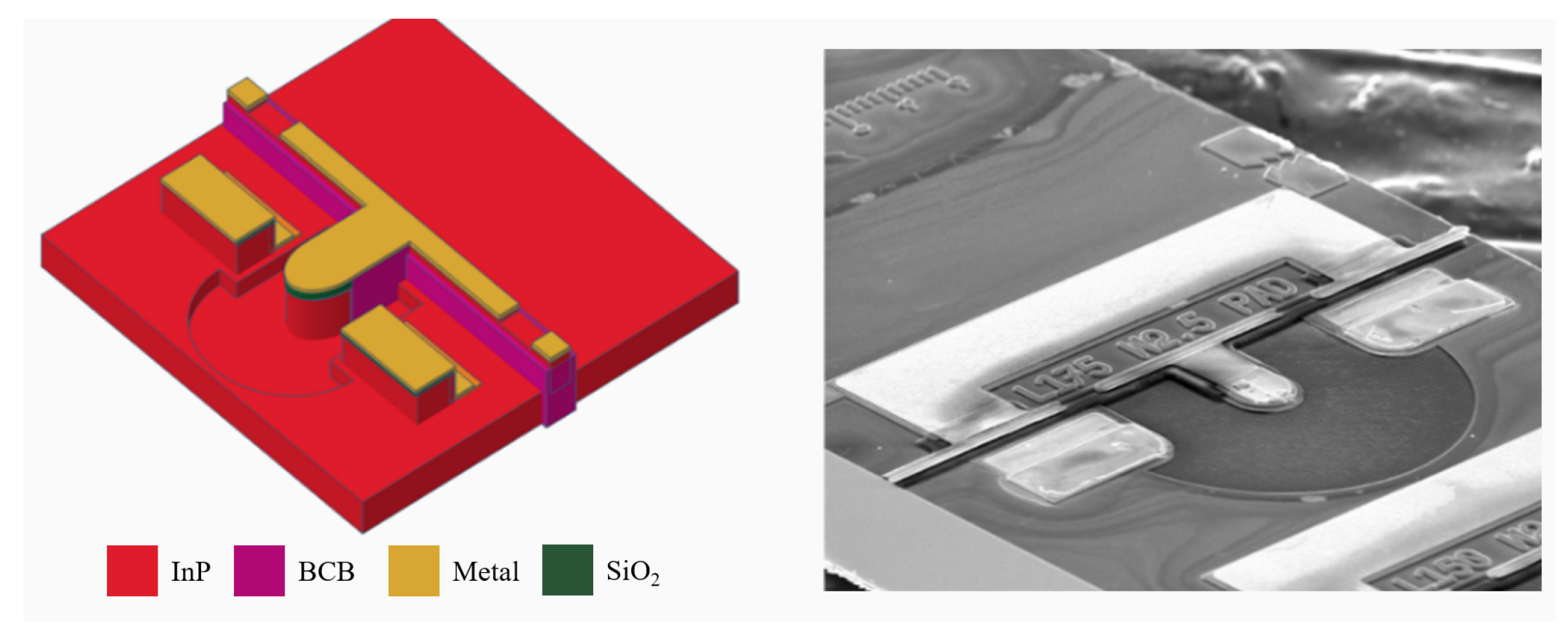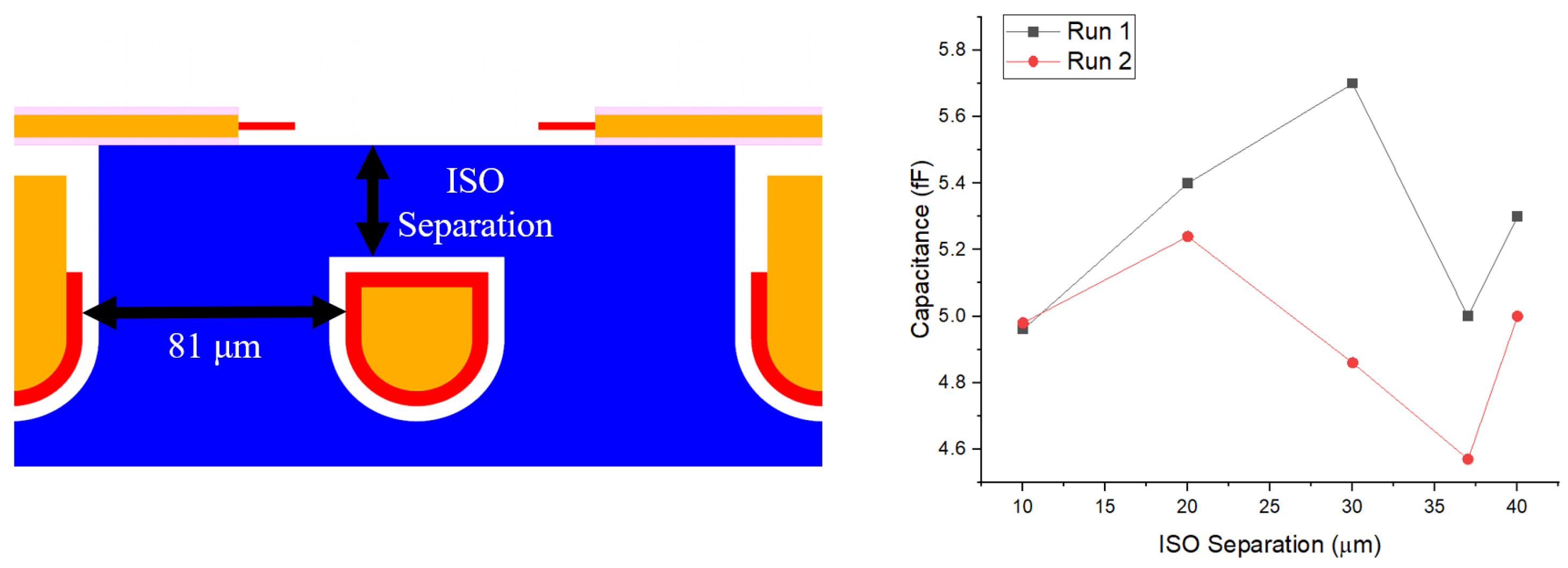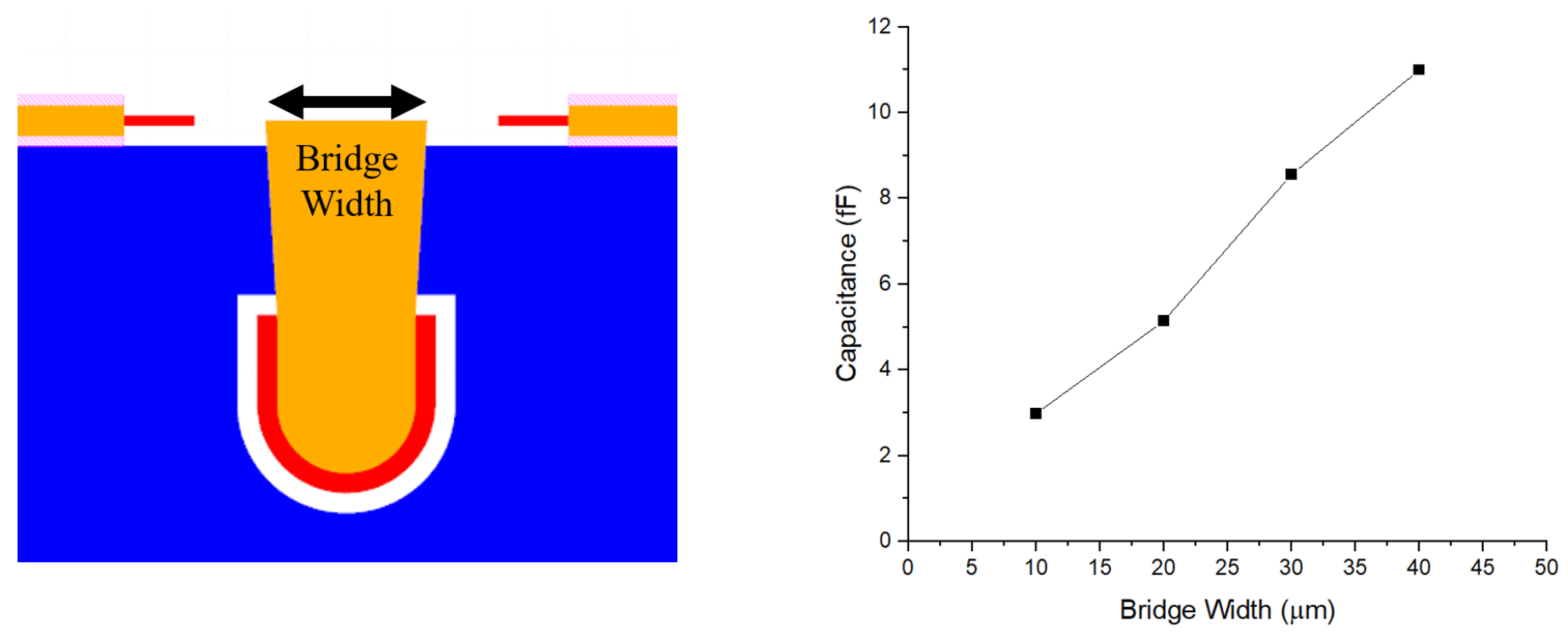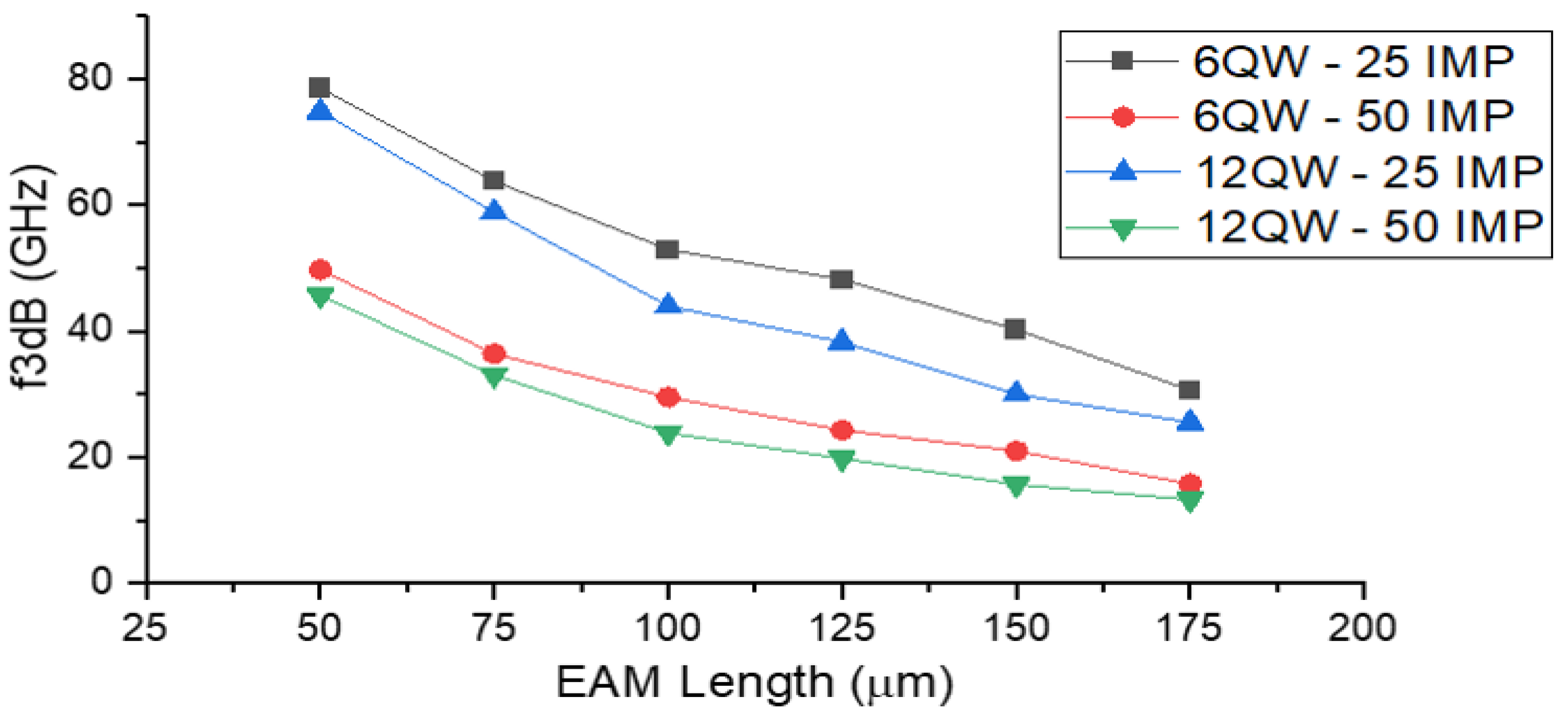Minimisation of Parasitic Capacitance in Lumped-Element Electro-Absorption Modulators for High-Speed Optical Components
Abstract
1. Introduction
2. Device Design
3. Equivalent Circuit Modelling
4. Contact Scheme Optimisation
4.1. Contact Pad Optimisation
4.2. Metal Bridge Optimisation
5. EAM Measurements
6. Conclusions
Author Contributions
Funding
Institutional Review Board Statement
Informed Consent Statement
Data Availability Statement
Conflicts of Interest
References
- IEEE P802.3df 200 Gb/s, 400 Gb/s, 800 Gb/s, and 1.6 Tb/s Ethernet Task Force. Available online: https://www.ieee802.org/3/df/index.html (accessed on 21 April 2022).
- Ethernet Alliance. The 2018 Ethernet Roadmap. October 2018. Available online: https://ethernetalliance.org/the-2018-ethernet-roadmap (accessed on 1 July 2023).
- Ozolins, O.; Pang, X.; Olmedo, M.I.; Kakkar, A.; Udalcovs, A.; Gaiarin, S.; Navarro, J.R.; Engenhardt, K.M.; Asyngier, T.; Schatz, R.; et al. 100 GHz Externally Modulated Laser for Optical Interconnects. J. Light. Technol. 2017, 35, 1174–1179. [Google Scholar] [CrossRef]
- Nakai, Y.; Nakanishi, A.; Yamaguchi, Y.; Yamauchi, S.; Nakamura, A.; Asakura, H.; Takita, H.; Hayakawa, S.; Mitaki, M.; Sakuma, Y.; et al. Uncooled Operation of 53-GBd PAM4 (106-Gb/s) EA/DFB Lasers with Extremely Low Drive Voltage with 0.9 Vpp. J. Light. Technol. 2019, 37, 1658–1662. [Google Scholar] [CrossRef]
- Mastronardi, L.; Banakar, M.; Khokhar, A.Z.; Hattasan, N.; Rutirawut, T.; Bucio, T.D.; Grabska, K.M.; Littlejohns, C.; Bazin, A.; Mashanovich, G.; et al. High-speed Si/Gesi hetero-structure electro absorption modulator. Opt. Exp. 2018, 26, 6663–6673. [Google Scholar] [CrossRef] [PubMed]
- Shahin, M.; Vaskasi, J.R.; Kerrebrouck, J.V.; Abbasi, A.; Gasse, K.V.; Muneeb, M.; Breyne, L.; Ossieur, P.; Yin, X.; Bauwelinck, J.; et al. Demonstration of 80 Gbps NRZ-OOK Electro-Absorption Modulation of InP-on-Si DFB Laser Diodes. In Lasers and Electro-Optics; OSA Technical Digest; Optica Publishing Group: Washington, DC, USA, 2019. [Google Scholar]
- Keyvaninia, S.; Muneeb, M.; Stankovic, S.; Veldhoven, P.J.V.; Thourhout, D.V.; Roelkens, G. Ultra-thin DVS-BCB adhesive bonding of III-V wafers, dies and multiple dies to a patterned siliconon-insulator substrate. Opt. Mater. Express 2012, 3, 35–46. [Google Scholar] [CrossRef]
- Zhang, J.; Haq, B.; O’Callaghan, J.; Gocalinska, A.; Pelucchi, E.; Trindade, A.J.; Corbett, B.; Morthier, G.; Roelkens, G. Transfer-printing-based integration of a III–V-on-silicon distributed feedback laser. Opt. Express 2018, 26, 8821–8830. [Google Scholar] [CrossRef]
- Kawanishi, H.; Yamauchi, Y.; Mineo, N.; Shibuya, Y.; Murai, H.; Yamada, K.; Wada, H. EAM-integrated DFB laser modules with than 40 GHz bandwidth. IEEE Photonics Technol. Lett. 2001, 13, 954–956. [Google Scholar] [CrossRef]
- Daunt, C.L.L.; Hua, Y.; O’Callaghan, J.; Young, R.J.; Thomas, K.; Pelucchi, E.; Corbett, B.; Peters, F. Design of single growth epitaxial structures for monolithic integration of single frequency laser and electro-absorption modulators. In Proceedings of the 2009 IEEE LEOS Annual Meeting Conference Proceedings, Belek, Antalya, Turkey, 4–8 October 2009. [Google Scholar]
- Asakura, H.; Nishimura, K.; Yamauchi, S.; Nakai, Y.; Suzuki, T.; Yamaguchi, Y.; Tani, K.; Nakajima, R.; Naoe, K. 420 Gbps PAM8 Operation Using 93 GHz Bandwidth Lumped-Electrode Type EA-DFB Laser at 50 °C beyond 400 Gbps/lane. In Optical Communication (ECOC) 2022; Leuthold, J., Harder, C., Offrein, B., Limberger, H., Eds.; Technical Digest Series; Optica Publishing Group: Washington, DC, USA, 2022. [Google Scholar]










Disclaimer/Publisher’s Note: The statements, opinions and data contained in all publications are solely those of the individual author(s) and contributor(s) and not of MDPI and/or the editor(s). MDPI and/or the editor(s) disclaim responsibility for any injury to people or property resulting from any ideas, methods, instructions or products referred to in the content. |
© 2023 by the authors. Licensee MDPI, Basel, Switzerland. This article is an open access article distributed under the terms and conditions of the Creative Commons Attribution (CC BY) license (https://creativecommons.org/licenses/by/4.0/).
Share and Cite
Mulcahy, J.; Shi, S.; Peters, F.H.; Dai, X. Minimisation of Parasitic Capacitance in Lumped-Element Electro-Absorption Modulators for High-Speed Optical Components. Photonics 2023, 10, 885. https://doi.org/10.3390/photonics10080885
Mulcahy J, Shi S, Peters FH, Dai X. Minimisation of Parasitic Capacitance in Lumped-Element Electro-Absorption Modulators for High-Speed Optical Components. Photonics. 2023; 10(8):885. https://doi.org/10.3390/photonics10080885
Chicago/Turabian StyleMulcahy, Jack, Shengtai Shi, Frank H. Peters, and Xing Dai. 2023. "Minimisation of Parasitic Capacitance in Lumped-Element Electro-Absorption Modulators for High-Speed Optical Components" Photonics 10, no. 8: 885. https://doi.org/10.3390/photonics10080885
APA StyleMulcahy, J., Shi, S., Peters, F. H., & Dai, X. (2023). Minimisation of Parasitic Capacitance in Lumped-Element Electro-Absorption Modulators for High-Speed Optical Components. Photonics, 10(8), 885. https://doi.org/10.3390/photonics10080885




